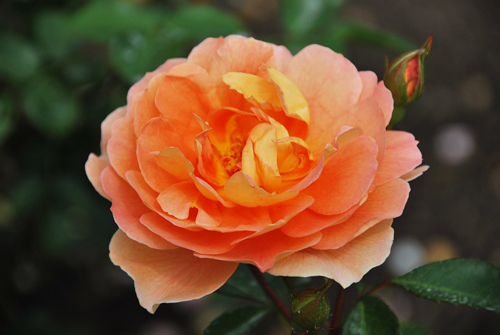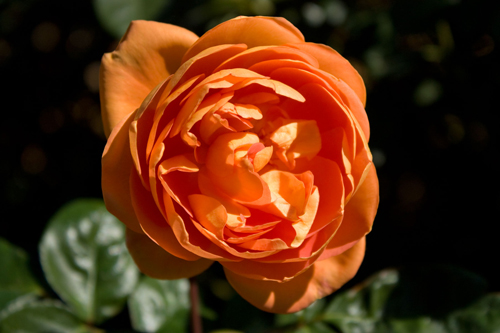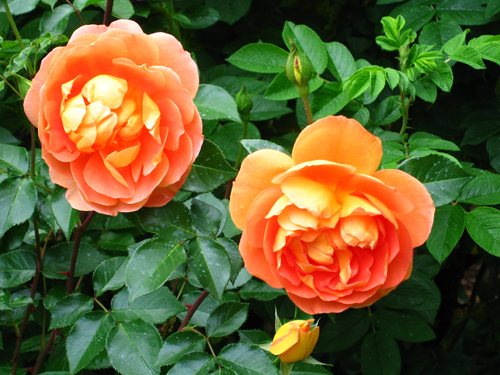Rose Pat Austin
Well-known to rose growers "English roses", created by David Austin, are not officially singled out as a separate group. But, nevertheless, it is they who are considered to be the hallmark of English rose growing. These magnificent creatures differ from other known varieties in the structure of the flower and bush. At the end of the twentieth century, Austin creates perhaps one of his most famous creations - the charming Pat Austin. The variety not only combined the charm of old roses and the repeated blooming inherent in modern varieties, it became a real breakthrough in the colors of "English roses", because before the appearance of our heroine, this group was mainly presented in soft pastel colors.

History of creation
Pat Austin is a representative of the English selection. She was created in the family nursery David Austin Roses Limited. An adorable variety was bred by David Austin and named after his beloved wife Pat Austin, a very talented and gifted woman. It is her sculptures that occupy key places in the David Austin Rose Garden, located in Albright. This wonderful park annually attracts a lot of tourists who come to admire the collection of 800 kinds of beautiful flowers of various colors. To create a future masterpiece, the breeder used the well-known varieties as parents - large-flowered Abraham darby and deep yellow Graham Thomas. In 1993, our heroine was selected from the samples received. In 1995, the gorgeous novelty was introduced in the UK as Pat Austin. The registration name consists of the original letter code and sounds like AUSmum. In 1996, a patent for the cultivation of a new variety was received in Canada, Europe and the USA. In 1999, a charming Englishwoman is presented in Australia.
Awards
In 1998 - a test certificate of the Adelaide Rose Competition (Australia). In 2001 - the award "Garden Merit" of the Royal National Rose Society of Great Britain RNRS. In addition, our heroine received a quality mark from the British Royal Horticultural Society (RHS).

Description
Pat Austin belongs to the class of scrubs, that is, spray roses. The plant is medium-sized, spreading, the height of the bush is about 90 - 105 cm. It can grow up to 120 cm wide. In shape, the bush of our heroine looks somewhat loose, but neat, it is often compared with Golden celebration and Abraham darby. Many gardeners write that in hot climates, growth is rather moderate, or even weak at all, therefore the height of the shrub is somewhat lower. Shoots are upright, red-brown, thin, with large thorns. Moderate leafiness. Leaves are odd-pinnate, rather large, green. There are 5 leaf blades, they have a smooth shiny surface, look decorative and perfectly set off the bright color of flowers. Basically, the stem ends in one flower, but sometimes forms a small inflorescence, consisting of 3 - 7 buds. When the flowers bloom, the shoot is often unable to keep the large inflorescence upright and droops.
The buds are long, ovate-pointed. The flower rosette is large, drooping, 10 - 12 cm in diameter, full, semi-double, consisting of more than 40 petals. The shape is deeply cupped, reminiscent of old roses. At the beginning of the dissolution, the outer petals gracefully fold back, while the inner ones remain tightly compressed. Gradually opening up, the flower exposes the middle, decorated with red stamens. The color range of the variety combines copper, coral and amber tones. The color of the beautiful rose cannot be described, it shimmers, changes depending on the stage of disclosure. The gorgeous rosette shape at the beginning of the dissolution creates a wonderful color effect, allowing you to admire the color contrast on the two sides of the petal. The outer side is a pale copper-yellow color, while the inner side of the petals shines with bright copper.

Flowering period
Feminine Pat Austin is a multi-flowering species.The plant, with good care, is capable of blooming in tides throughout the season. The English aristocrat blooms quite early - in May. The flowering period is long, lasts until October and ends only with the onset of cold weather. Bud formation is quite abundant, but flower rosettes bloom gradually. The blooming period of a rose directly depends on the location of the bush. In partial shade, the flowers can last for about 4 - 6 days, allowing you to admire the play of warm shades of culture to your heart's content. But in the heat in the sun, the flower grows old by the evening, without having time to completely please with its shape and colors. The aroma is strong enough, like the tea varieties.
To maintain flowering in June, the bush is fed with nitrogen-containing fertilizers. During the budding period, one cannot do without phosphorus-potassium dressings. Faded rosettes must be removed in time so that the plant redirects its forces to the formation and development of new buds.
Characteristics
- Already in the second year after planting, the beautiful Pat Austin is able to show full flowering;
- the bright color of roses is well manifested in spring and autumn, that is, in cool weather. In the sun, colors fade, copper acquires pink hues, and amber yellow practically becomes cream;

- Pat Austin prefers a temperate climate. It does not tolerate temperature changes well. In the heat, the activity of the flower decreases somewhat, although gardeners note that bud formation does not completely stop even at an air temperature of about + 35 ° C;
- the declared sixth zone of frost resistance corresponds to the USDA system adopted by the US Department of Agriculture. Perennial perfectly withstands frosts down to -23.3 ° C. But if there is a shelter, it can winter well in cooler regions. Returning early spring frosts can pose the main danger to the culture;
- the immunity of the variety is not high enough. Gardeners often note that the plant can get black spot even in warm and dry weather. In relation to powdery mildew, resistance is average, as a rule, the disease is most dangerous in epiphytic years. In rainy weather, the plant can suffer from gray mold. There is evidence that rust can also harm the rose;
- poor resistance to rain. From high humidity, delicate petals deteriorate, rot. In the rainy period, the bud that has begun to bloom pupates and withers, and does not bloom completely;
- Pat Austin is not very suitable for cutting. The shoots are not strong enough to hold the inflorescence, and the flowers themselves are drooping.
Agrotechnics
Pat Austin cannot be called an unpretentious culture; the English lady is rather capricious. Before planting a rose, find a suitable place for it. In central Russia, sunny places can be allocated for landing, but in the hottest period, light penumbra will be very useful. In the south, you need to find a place where the sun will illuminate the bush only until noon.
Prepare the planting pit in advance by filling it with a nutritious soil mixture, to which baking powder must be added to improve the structure. For ostinka, correct pruning is of great importance - formative and sanitary, increasing bud formation and reducing the risk of spreading fungal infection. The drooping shape of the bush, which, according to the author, looks natural, is not always to the liking of rose growers who do not want to put up with the fact that fragile shoots sometimes simply lie on the ground under the weight of inflorescences. In this case, you can build supports about half the height of the bush, thanks to which the plant does not fall apart. Some rose growers grow our heroine on a trunk, it looks very original and the lodging shoots will not reach the ground. In addition, the culture can be grown in flower pots, however, this applies rather to young plants.Due to the insufficient resistance of the rose to diseases, it is necessary to carry out preventive spraying in a timely manner.
Landscape design
The variety, thanks to a neat, but at the same time, fluffy bush, covered with an unusual color with semi-double flowers, is capable of radically transforming any garden corner. Pat Austin can become the main element of decor in a flower bed, in a flower garden, in a mixborder. The culture is used to create low decorative hedges. It also looks great in group plantings, for example, against the background of coniferous perennials, or as a decoration for a cozy summer gazebo for relaxation.
Pat Austin, though finicky, is a very beautiful, delicate and feminine rose. She is not very healthy, does not tolerate heat, wind and rain. But today, thanks to the unusual color, our heroine can be called the most recognizable variety in the world. Of course, in order for the beauty to fully show decorative qualities, you have to work hard. But these efforts will pay off with the sense of delight that a flourishing culture evokes.
This is how the flower world is arranged that annually outdated pink varieties that have revealed any serious shortcomings are removed from circulation. Reputable David Austin Roses Limited also uses this practice. Pat Austin was discontinued in 2016. But at the same time, rose growers still have the hope that the variety will return, updated, but still just as beautiful.








